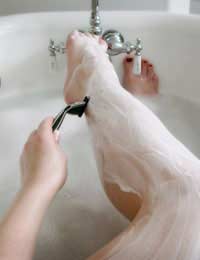The Importance of Good Preparation Before Removing Hair

No matter which hair removal method you choose (shaving, waxing, electrolysis, plucking, or depilatories) the key to getting the smoothest, closest, most comfortable result lies in the pre-preparation of the skin.
The Importance of Good Preparation Before Hair Removal
During any hair removal process the skin is subjected to harsh conditions. When shaving with a razor the blade pulls at the skin, and roughs up the surface cells. When waxing the skin is tugged on and cells can be pulled loose resulting in tiny skin abrasions. When plucking is used to remove hairs the cells surrounding the hair follicle can be damaged. Depilatories contain harsh chemicals that can irritate the skin, and electrolysis can affect surrounding skin cells causing burning, redness, and painful irritation.Since the skin is at risk of damage during any hair removal process it is best to prep the skin as much as possible in order to reduce or eliminate the extent of the damage. Plus, good preparation can also soften or weaken the hair shaft so that removal is quicker and easier- reducing the amount of time that the skin is subjected to the hair removal process.
How to Prep the Skin Before Hair Removal
A good hair removal preparation process involves three steps- exfoliation, hydrating, and moisturising. Exfoliation removes dead skin cells that can block hair growth and allows for a closer, more comfortable shave. Simply massaging the skin with a wet, soapy washcloth in a circular motion can exfoliate the skin. However, there are many exfoliating creams, soaps, and gels on the market that work to soften the skin so that exfoliation is easier and gentler.The next step- hydrating- helps soften the hairs and plump them up for easier removal. Before shaving or waxing wet the area of desired hair removal with warm water for at least three to five minutes. The hair will absorb the water causing it to thicken and stand up away from the skin. This will help the razor remove the hair lower on the hair shaft for a closer shave. It will also help the wax adhere to each individual hair better. Plus, the water will help open up the pores of the skin making hair shaft removal more complete and gentler.
Finally, applying a moisturising lotion or oil to the skin before hair removal can help eliminate any skin irritations that the process may cause. For example, applying moisturising oil before shaving can help reduce razor friction on the skin and eliminate razor burn. Specially formulated lotions that are applied before waxing can help reduce the "hold" of the wax on the skin cells and eliminate skin abrasions and irritation. Finally, moisturising softens the skin and leaves behind a protective layer of lubricant that helps minimise the effects of any hair removal process.


Re: Cost of Electrolysis
I have such a hairy body, there is hair every where I am so self conscious about this everyday. I want to permanently remove hair from…
Re: Impact of Electrolysis on the Skin
Unfortunately, skin pitting and scarring is not a rare side effect of electrolysis. I have facial hair resulting from a…
Re: Cost of Electrolysis
My name is ali . I want to shape up my beard line including neck . I want to know how many sessions do i need ? And time gap between each…
Re: Cost of Electrolysis
I would recommend that you buy low cost waxing strips from your local super drug store use that in the mean time until you can save up for…
Re: Cost of Electrolysis
How do I get rid of body hair cause when I was small I shaved my stomach and chest hair for no damn reason and I waxed it 2 times and am sooo…
Re: Should Pre-Teen Girls Be Allowed to Shave?
Hair doesn't actually get much thicker by shaving, it's because of the blunt cut or because you are growing up.
Re: Impact of Electrolysis on the Skin
I am a teenaged girl and I'm very self conscious about my body hair and I don't know how to ask my mum for the treatment…
Re: Impact of Waxing on Skin
Hi, I too am currently studying waxing and and need help with some questions for my assignment. 1. The structural levels of…
Re: Impact of Electrolysis on the Skin
Can you get permanent damages or paralysis if they do it wrong ?? ??
Re: Impact of Electrolysis on the Skin
Lena, I wish I had researched more (or even read your comments). Just had 6 laser sessions on my lip and have now started…